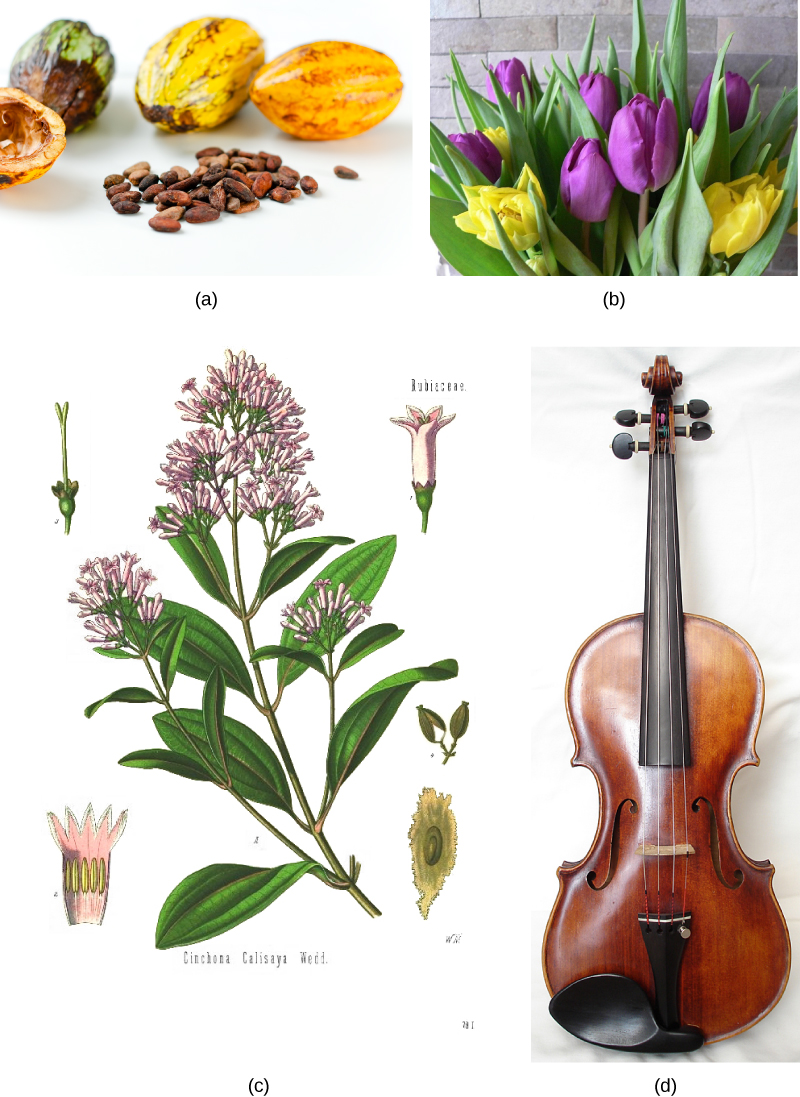| << Chapter < Page | Chapter >> Page > |
Staple crops are not the only food derived from seed plants. Fruits and vegetables provide nutrients, vitamins, and fiber. Sugar, to sweeten dishes, is produced from the monocot sugarcane and the eudicot sugar beet. Drinks are made from infusions of tea leaves, chamomile flowers, crushed coffee beans, or powdered cocoa beans. Spices come from many different plant parts: saffron and cloves are stamens and buds, black pepper and vanilla are seeds, the bark of a bush in the Laurales family supplies cinnamon, and the herbs that flavor many dishes come from dried leaves and fruit, such as the pungent red chili pepper. The volatile oils of flowers and bark provide the scent of perfumes. Additionally, no discussion of seed plant contribution to human diet would be complete without the mention of alcohol. Fermentation of plant-derived sugars and starches is used to produce alcoholic beverages in all societies. In some cases, the beverages are derived from the fermentation of sugars from fruit, as with wines and, in other cases, from the fermentation of carbohydrates derived from seeds, as with beers.
Seed plants have many other uses, including providing wood as a source of timber for construction, fuel, and material to build furniture. Most paper is derived from the pulp of coniferous trees. Fibers of seed plants such as cotton, flax, and hemp are woven into cloth. Textile dyes, such as indigo, were mostly of plant origin until the advent of synthetic chemical dyes.
Lastly, it is more difficult to quantify the benefits of ornamental seed plants. These grace private and public spaces, adding beauty and serenity to human lives and inspiring painters and poets alike.

The medicinal properties of plants have been known to human societies since ancient times. There are references to the use of plants’ curative properties in Egyptian, Babylonian, and Chinese writings from 5,000 years ago. Many modern synthetic therapeutic drugs are derived or synthesized de novo from plant secondary metabolites. It is important to note that the same plant extract can be a therapeutic remedy at low concentrations, become an addictive drug at higher doses, and can potentially kill at high concentrations. [link] presents a few drugs, their plants of origin, and their medicinal applications.
| Plant Origin of Medicinal Compounds and Medical Applications | ||
|---|---|---|
| Plant | Compound | Application |
| Deadly nightshade ( Atropa belladonna ) | Atropine | Dilate eye pupils for eye exams |
| Foxglove ( Digitalis purpurea ) | Digitalis | Heart disease, stimulates heart beat |
| Yam ( Dioscorea spp.) | Steroids | Steroid hormones: contraceptive pill and cortisone |
| Ephedra ( Ephedra spp.) | Ephedrine | Decongestant and bronchiole dilator |
| Pacific yew ( Taxus brevifolia ) | Taxol | Cancer chemotherapy; inhibits mitosis |
| Opium poppy ( Papaver somniferum ) | Opioids | Analgesic (reduces pain without loss of consciousness) and narcotic (reduces pain with drowsiness and loss of consciousness) in higher doses |
| Quinine tree ( Cinchona spp.) | Quinine | Antipyretic (lowers body temperature) and antimalarial |
| Willow ( Salix spp.) | Salicylic acid (aspirin) | Analgesic and antipyretic |

Notification Switch
Would you like to follow the 'Bi 101 for lbcc ilearn campus' conversation and receive update notifications?